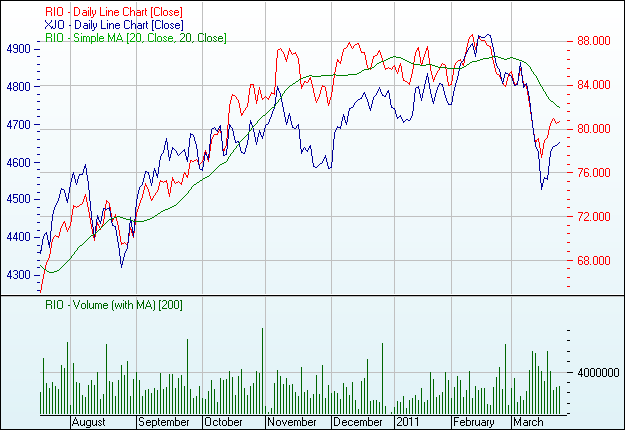
Rio Tinto is complaining that governments are seeking rents when the rents should obviously go to Rio Tinto, as my co-blogger Houses and Holes pointed out. More pragmatically, is the stock accurately priced? Brokers are mostly putting buys on it, because that is the obvious thing to do. Yes, its very, very big — big enough to boss governments around, at least in its own mind — but has the market got it right? It will certainly attract institutional allocations — and automatic buy recommendations from brokers for the most part — just because of its size. Especially now that its gearing is negligible. Southern Cross argues that the market is undervaluing its aluminium assets.
A Southern Cross report notes that no-one disputes that the Alcoa acquisition was ill timed and too expensive — even Rio management. But after four years and much cost reduction, Southern Cross believes the aluminium assets, which are 60% of operating assets, are a sleeper not fully appreciated.
Southern Cross has lifted earnings forecasts by 10% despite downgrades to its uranium forecast and expecting an adverse effect on costs from higher oil costs. The aluminium business gives Rio strong leverage to what Southern Cross thinks will be a recovering aluminium price. Rio is trading on a forward price earnings ratio of 7.9 times, which does make it look cheap (dividend yield 1.9%). Southern Cross has a target price of $109. And it also believes there are good signs in the aluminium forward market:
The market is forward pricing aluminium at a premium to our new higher price forecasts. We have increased to US$1.17/lb for 2012E then expect further rises to US$1.20/lb for 2013E and 2014E, and we use a long term price of US$1.00/lb (2011$, no revision). The market is targeting similar prices for 2012E but is expecting stronger gains than our base case for 2013E and beyond. The aluminium price forward curve approaches an asymptote of US$1.30/lb out there in 2021, which in 2011$ real is US$1.08/lb. This compares to our base case long term price of US$1.00/lb (2011$ real).
Morningstar uses an intriguing chocolate bar measure on iron ore prices. Iron ore is 40% of Morningstar’s Rio valuation and 25% of BHPs. Morningstar compares iron ore prices to chocolate bars (a bit like the Mac index in The Economist). That approach does suggest significant downside risk on iron ore prices:
The recent US$200 iron ore price peak meant a tonne of iron ore cost over 300 1oz Hershey chocolate bars, triple the 25 year average to 2005. A bubble or a new paradigm? Our iron ore valuations don’t take a chance on the former. Our long term real (un inflated) iron ore price forecast is US$70/tonne. On the chart above this displays as just over US$80/tonne in 2017 employing a long term US inflation rate of 2.3%. Coincidently this would bring iron ore back to that long term 100 Hershey chocolate bar ratio, assuming the 30-year trend in chocolate price increase continues.
So it may be the case that Rio’s aluminium “sleeper” will have to be matched off against Rio’s vulnerability on iron ore. Rising iron ore prices have resulted in Rio’s margins rising from 50% last decade to 70% last year. That means the company is awash in cash. But for how long? Morningstar, by the way, has a buy.